Top News
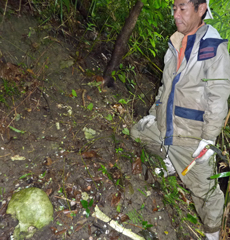
June 16, 2012 Ryukyu Shimpo
On June 15, in the Kochi area of Nishihara, seven sets of remains that seem to have been soldiers and young civilian personnel of the Imperial Japanese Army during the Battle of Okinawa were found. Among those, there are skulls and teeth with three sets of remains. Yoshikiyo Takaesu, a representative of Gamafuya, the volunteer group dedicated to the recovery of remains of the Battle of Okinawa, said, “If we can carefully collect these remains, we should be able to find something to identify them from. The teeth of the remains are really well preserved, so we may be able to conduct DNA testing on them.” The group hopes to collect the remains and return them to the bereaved families.
Takaesu found the remains them this January scattered along a 200 meter-long ridge of a steep slope. Considering their state and the location they were in, the local police first looked to confirm that there were no related incidents on file. Bone thickness would suggest that two of the three remains that had teeth were young boys. It is possible that they were students mobilized during the Battle of Okinawa. Black buttons and a safety-pinned name-tag that did not belong to a military uniform, were found near one set of remains, but the name could not be identified.
During the Battle of Okinawa, the 11th Company of the 22nd Infantry Regiment was stationed at Kochi, where many artillery shells were later found. Five remains were found in a cave in 2009. At the request of Gamafuya, the Japanese government has been conducting DNA testing on the remains as well as on people who could possibly be the bereaved families. Takaesu said, “The fact remains are still being found despite 67 years having passed since the end of the war is testimony to cruelty of the war. I hope that as many sets of remains as possible can be returned to the bereaved families.
(English translation by T&CT, Mark Ealey)
Go to Japanese
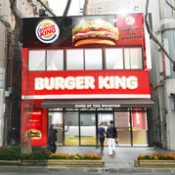
June 14, 2012 Ryukyu Shimpo
In early August, the U.S. fast food hamburger chain from Miami, BURGER KING (BK) will open its first Okinawan outlet in Makishi, Naha. It will be open every day from 7:00am to 11:00pm. The store will have 83 seats, including 14 seats in a smoking area. While it is a familiar hamburger chain to people on the U.S. military bases in Okinawa, it will be the first outlet located outside of the bases.
As of June 13, BK has 44 outlets throughout Japan outside U.S. military bases. Including this one in Okinawa, BK plans to have opened 300 outlets in Japan by 2015. A spokesman for the company says, “American culture has permeated the market in Okinawa. BK has already opened on the bases and has an established profile. Hamburger consumption per person in Okinawa is the highest in Japan, and the presence of many foreigners and tourists contribute to this. We decided to open a shop early in Okinawa because it is the most likely to have an pre-existing level of demand.”
On June 13, BURGER KING Asia Pacific, which handles BK in Asia, BURGER KING Japan, and Okinawa BURGER KING (OBK), which oversees the Okinawa area, agreed on a franchising contract for store development in the prefecture. The main sales point of BK is that its large beef patties are grilled over an open flame rather than on an iron hotplate, and the most popular product is the “Whopper,” which has lettuce, tomato, onion, and a meat patty and is a large 13 centimeters in diameter.
OBK was established in May 2012 as the BURGER KING company for the Okinawa area. In Ishigaki City, the company president, Ichiro Ohama, manages the industry and hotel management Ishigaki SS Group, and the restaurant business Orito Foods.
(English translation by T&CT, Megumi Chibana and Mark Ealey)
Go to Japanese
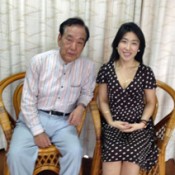
June 11, 2012 Sadao Tome, Correspondent of the Ryukyu Shimpo
On the occasion of the 40th anniversary of Okinawa’s reversion from U.S. rule to Japanese sovereignty, Japan Times reporter Ayako Mie visited the prefecture for four days at the beginning of May, reporting about the current situation of the Okinawan dialect, Uchinaguchi. Mie published the articles about the gradual demise of Uchinaguchi in the Japan Times. She interviewed three people involved in Uchinaguchi – Byron Figa and Masamitsu Kohatsu, comedians who launched the comedy group Owarai Beigun Kichi, or Comedy U.S. Base, to caricature issues related to the U.S. military bases in Okinawa, and Japanese Brazilian Akira Uema. Before carrying out her interviews, Mie met Eikichi Hateruma, professor of the Okinawa Prefectural University of Arts, and did some research into the historical background of Uchinaguchi.
Mie wrote about how Figa, who was born to an American father and an Okinawan mother, writes columns for newspapers and constantly strives to promote Uchinaguchi. She wrote that Kohatsu satirizes the issues surrounding the U.S. military bases in Okinawa for comedy performances that use a great deal of Uchinaguchi. Third-generation Okinawan Brazilian Uema, who was born in Brazil, bought textbooks on Uchinaguchi through Amazon.com and studied them every day. Although Uema came to Okinawa to study Uchinaguchi to a deeper level, he was disappointed to find that few young people in Okinawa could actually understand the language. Mie wrote about how Uema decided that if Okinawan people would not strive to preserve their beautiful language, he would try to promote it by himself.
After graduating from university in 2001, she started to work for Tokyo Broadcasting System Television. She was awarded a Fulbright Scholarship, which allowed her to study at the Berkeley Graduate School of Journalism in the University of California, where she wrote her masters thesis on the topic of Okinawa. In the thesis, she made reference to Chogi Higa, Takeo Knashiro and Sadao Tome as Okinawan journalists active in the United States.
In her articles Mie pointed out that although language and culture are recognized as the most important factors for forming a person’s identity, the mainstream English media hardly ever refer to the discrimination and colonialist attitudes taken towards Okinawa from those perspectives. Mie said that lately the mainstream English media does not show any interest in the issue of the U.S. military bases in Okinawa, so she wanted to describe the path that the Okinawa people followed for the last 40 years, from different perspectives than those of the U.S. military issue.
(English translation by T&CT, Mark Ealey)
Go to Japanese
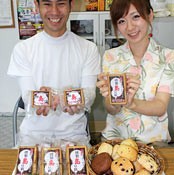
June 10, 2012 Ryukyu Shimpo
Tofu production and distribution company Ikeda Shokuhin has been working to commercialize a new product of Okinawan tofu, also known as shima-dofu. They not only started selling smoked shima-dofu in April, but also tried to make scones and cookies from okara or soy pulp created as a by-product when making tofu. The company president, Hiroshi Zukeran said, “Many people may have a preconception that Okinawan tofu is achikoko (hot in Uchinaguchi) or that it comes in a pack, but I want to create new and unusual product angles for it.”
Smoked shima-dofu is made by exerting pressure on a cake of shima-dofu for three hours, before draining its water away and soaking it in their original soy sauce flavor mixture for two days. After that it is dried for six hours and smoked with cherry chips for another 12 hours. They came up with the recipe for the original sauce mixture through about two months of trial and error.
When Zukeran went to a tofu trade fair in Tokyo, he saw various products, such as tofu ice cream, that inspired him to try creating something new, and the taste of smoked tofu that he ate there gave him a clue. Up to now, he had offered leftover shima-dofu that had gone cold at supermarkets as food for livestock, but he always wanted to somehow recycle that unsold product and that desire helped drive him to look for ideas.
The company began marketing the new tofu goods in April and now distributes them to various restaurants and bars. For large retailers, from June 9 they are selling them at Keibin-eki Kariyushi-ichi in Ozato, Nanjo, also at Ameku Ryubo in Naha, and at the Farmer’s Market in Agarihama, Yonabaru from July. They hope to sell 120 packs per week.
Asami Zukeran, the wife of the company president, who works in the planning division, has carried out research into the use of raw leftover bean curd, making scones and cookies experimentally for an industrial exhibition and a handmade goods market.
The suggested price excluding tax of the smoked shima-dofu is from 280 yen for one block, and from 550 yen for two blocks. For further details, call Ikeda Shokuhin on 098 (945) 0279.
(English translation by T&CT, Lima Tokumori and Mark Ealey)
Go to Japanese
June 9, 2012 Sakae Toiyama of Ryukyu Shimpo
The U.S. Government has concluded that no mechanical problems were found to be involved in the MV-22 Osprey vertical take-off and landing transport aircraft crash in Morocco in April. Receiving the report from the United States government, a senior official of the Ministry of Defense commented, “The safety of the aircraft has been confirmed.” So the Japanese government has issued a declaration on the safety of the aircraft before the final report has actually been submitted to Tokyo by the U.S. government. It is unlikely that an independent investigation will be carried out on the crash. On this issue, the government goes no indication of any desire to edge closer to the Okinawan people, who are extremely concerned about this dangerous aircraft coming to the base at Futenma.
A senior official of the Ministry of Defense indicated his confidence in the safety of the aircraft, saying, “The accident analysis report by the U.S. government covers the safety issue that the Okinawa Prefectural Government has been concerned about. This will relieve the concern of local people because the crash was not due to mechanical failure.” Another senior official commented, “Human error caused the crash, and it was made clear that the aircraft had no structural defects. The Japanese government is not in a position to comment to the United States on the Osprey deployment plan to the base at Futenma.” The Japanese government will not request that the U.S. government delay its schedule. On March 8, in a press conference, Chief Cabinet Secretary Osamu Fujimura said, “We will press ahead with the deployment plan without making a fuss about it.”
The Japanese government received the summary of the crash investigation report from the United States government in the morning of June 7, but that was announced at a press conference at 9:30am the next day, June 8 with the press corps only being informed of the timing of the news conference just ninety minutes beforehand. Defense Minister Satoshi Morimoto mentioned the possible deployment of the Osprey to the Futenma base without waiting for the final report of the crash investigation. It is speculated that the local people’s growing opposition to the deployment of the Osprey made the government release the outline of the investigation report and that the timing of this was arranged with the United States.
At the same time, the Okinawa Prefectural Government follows these developments calmly. That same day, officials of the Okinawa Defense Bureau visited the Okinawa Government Office and the Ginowan Municipal Office, and delivered the one piece of written material that was announced to the press corps. In this no further information was given beyond what had been in the press releases. A senior official of the Okinawa Prefectural Government said, “Only one sheet paper was delivered to our office. We have not received the explanation [about the crash investigation].” He voiced his dissatisfaction with the central government, saying, “We want the government to provide more detail and accurate information. There might have been a problem in a system that led to human error occurring. We need further explanation.”
The U.S. government has conveyed to Tokyo only the conclusion of the crash investigation that no mechanical problems have been found, and has not actually released the official investigation report. However, the Ministry of Defense has obediently accepted this and issued a declaration of safety for the aircraft. The only thing that is conspicuous here is the determination to give priority to U.S. military operations.
(English translation by T&CT, Mark Ealey)
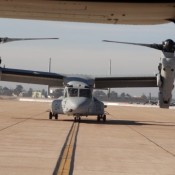
June 13, 2012 Hideki Matsudo of Ryukyu Shimpo reports from Washington D.C.
The lobby seeking to stop the procurement plan of the MV-22 Osprey vertical take-off and landing transport aircraft is becoming stronger in the United States. On May 17, Congressman Mike Quigley from Illinois put forward an amendment to cut defense funding for the Osprey in fiscal 2013. He pointed out that the Department of Defense had become a jobs program [for the Osprey] because 2000 companies supply parts for the Osprey from 40 states. Alluding to “pork-barrel politics,” the congressman referred to it as “dangerous pork with wings.” In the released report, the Center for a New American Security (CNAS), a prominent Washington think-tank that has influence on U.S. security policy, called on the Marine Corps to end its purchase program for the MV-22 Osprey in 2016 fiscal year in order to reduce defense spending.
A debate over the safety and financial burden of the Osprey has been kicked into life. The background to criticism of the procurement plan for the Osprey is a huge cut in defense spending due to financial difficulties. The U.S. government has outlined a budget request for the 2013 fiscal year (October 2012 – September 2013) that will cut the defense budget of $260 billion (about 20 trillion yen) over the next five years. The huge production cost of the Osprey has attracted great criticism because it will cost more that one million dollars or eight billion yen per aircraft. In addition to financial difficulties, the crash of an Osprey on April in Morocco has made people increasingly anxious.
“We are emerging from a recession. And we have limited resources, which means we have to make choices. Choosing to fund this over-budget, dangerous, non-essential plane means making cuts in other vital areas such as education, infrastructure, and healthcare,” said Quigley, calling for Congress to approve cuts to the budget for the Osprey. However his amendment to cut defense funding for this project was rejected by lawmakers representing constituencies related to the corporations that manufacture the aircraft. Quigley pointed out that the Bush administration had tried to freeze funding for the MV-22, but that Congress would not allow this because of the ramifications for employment. “If all we’re worried about is job creation, we’d be better off building bridges and transit programs. I want to save Marine lives,” he said.
In a new study issued in May entitled “Sustainable Preeminence: Reforming the U.S. Military at a Time of Strategic Change,” the CNAS, an influential think-tank in Washington D.C., opposed the procurement of the Osprey by the Marine Corps. The new study suggests that the Marine Corps may not be able to operate in anti-access and area denial (A2/AD) environments employed by China, and it recommends that the Corps should rely more on its sister services, the Air Force and Navy, and deepen the interdependence among the military services to reduce costs. The study suggests that the Marine Corps should cease MV-22 procurement in fiscal 2016 as one way of making budget savings.
However, there is strong speculation that the Department of Defense will continue to engage in the development and manufacture of the Osprey.
John T. Bennett for U.S. News & World Report commented that, “The Marines and their Boeing and congressional allies, however, have kept the MV-22 program going amid years of technological problems, making changes unlikely now that deployed Ospreys are performing well in combat.” While the Okinawan people’s concern about the Osprey deployment to the Futenma base is growing, the benefit to the military-industrial complex, including legislators, national armed forces and the defense industrial corporations, will take precedence over the controversial safety issue of the aircraft in the United States.
(English translation by T&CT, Mark Ealey)
Go to Japanese
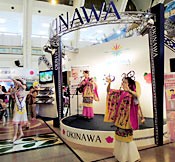
June 4, 2012 Ryota Kotani, Correspondent of the Ryukyu Shimpo
From May 10 to 13, the World Travel Fair 2012 was held at the Shanghai Exhibition Center in the Jingan district of Shanghai. Various countries and regions from around the world participated in the fair, running booths advertising aspects of their uniqueness and taste experiences. The participants held various events and promoted their activities.
Participants from Okinawa ran a booth featuring a blue minsah pattern, a traditional Ryukyuan textile associated with the blue color unique to Okinawa. Inside the booth, they exhibited products from Okinawa and screened a promotional video.
The participants set up a stage next to the booth on which sisters Yasue Kinjo and Tomoe Yogi gave a concert singing shimauta, or Okinawan traditional folk songs. Many visitors listened to the beautiful singing, the tune and rhythms being unfamiliar to their ears. At the end of the concert, the Okinawan participants explained how to perform kachasi, a traditional Okinawan dance. The dancing got the visitors up on their feet enjoying themselves.
Miss Okinawa Shoko Higa introduced the sea, nature and culture, and shopping information of Okinawa. She said to the visitors, “Okinawa is now in the tourist season. I really hope that you will come to see what we have to offer.”
The Okinawan participants held various events, in which the visitors wore garments made of bingata, Okinawan traditional resist dyed cloth for a commemorative photograph, and held a quiz about Okinawa which went down well with the visitors.
Several Okinawan companies also participated in the fair to promote tourism to the prefecture. Aesthetician Asami Miyagi, who works at a spa in Okinawa, said, “This is the first time for me to come to Shanghai. It was marvelous to meet customers here for whom I usually provide services for in Okinawa. I learned a great deal from this experience.”
It is important to raise the level of the Okinawan tourism industry and make Okinawa a more attractive tourist destination by actively sending people like Miyagi overseas who provide services to tourists, letting them deepen their knowledge and broaden their experiences.
(English translation by T&CT, Mark Ealey)
Go to Japanese
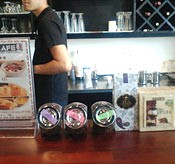
June 6, 2012 Ryukyu Shimpo
Cyurabana, a company based in Okinawa City that plans and markets products made using Okinawan natural materials, has started selling raffiane tea made with no additives, using only the benifuki variety of Okinawan tea leaves, at a cafe in China’s Sichuan Province in May. It has been also introduced on menus in the cafe as an Okinawan tea.
They plan to open a second store on June 10, and the company has been working hard to increase the number of new customers in the home of tea.
A major coffee supplier in Japan, Dart Coffee, and several business people who have companies in Okinawa and Taiwan, have recently established the cafe in China. Looking to the future, they are planning to expand the operation to 42 stores, including some in Taiwan.
Kanekawa Seicha, a tea company based in Nago, made the benifuki variety of raw materials, and the Cyurabana blends and sells it as raffiane tea. Cafes in resort hotels in Okinawa have been selling it since this January.
A spokesperson for Cyurabana commented, “We are very pleased to hear that people in Taiwan, the home of tea, have praised our tea as being delicious. We hope that tea growers in Okinawa will be encouraged by the market for tea expanding in this way.”
(English translation by T&CT, Lima Tokumori and Mark Ealey)
Go to Japanese
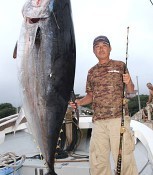
June 8, 2012 Yoko Morinaga, correspondent of Ryukyu Shimpo
On June 2, Hiroyuki Hirayama, a hobby fisherman from Nagoya, Aichi, pulled in a bluefin tuna 2.53 meters (8 feet 4 inches) long and weighing 287.5 kilograms (634 pounds) when fishing off Kumejima Island. It was his second such catch in two years. When he got back to Kanegusuku Port, fishing companions and local people welcomed he and praised him for his efforts.
Last year also, under the guidance of Takashi Nakamichi, the captain of the Taka-maru, and a member of the Kumejima Island Fisherman’s Association, Hirayama also landed a bluefin tuna of 286 kilograms (631 pounds). This year he pulled in a tuna in just about one hour.
“The fishing off Kumejima Island just is fantastic! Next year, I want to catch a tuna weighing over 300 kilograms (661 pounds),” he said with a smile.
(English translation by T&CT, Lima Tokumori and Mark Ealey)
Go to Japanese
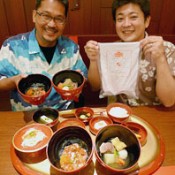
June 8, 2012 Sadaharu Shimabukuro of Ryukyu Shimpo
In order to attract foreign tourists from Islamic countries, collaborating with six hotels and restaurants in Okinawa, the Okinawa Tourist Service (OTS) drew up a project involving Ryukyuan dishes with Halal foods that Muslims are able to eat.
On June 10 and 11, the Ryukyuan dishes will be served to two groups of approximately 100 tourists who will visit Okinawa from Singapore. OTS will reserve places for the five prayers of Muslim practice. It is the first step by the OTS to target tourists from the Islamic world of over 1 billion people. Halal means “permissible” in Arabic and indicates what is legal conduct under Islamic law. Foods that are properly processed according to the law apply for a Halal mark of certification and are sold overseas. Japan also imports such Halal foods.
Muslims are forbidden to eat pork, and other meats such as beef and lamb also need to be handled according to prescribed methods of slaughtering. Alcohol including cooking sake and mirin is strictly prohibited as is the use of cooking utensils that have been used to prepare prohibited foods.
According to the OTS, Okinawa not catering for Halal or worship practices has made it difficult to attract tourist groups from Islamic areas of the world, but from January the OTS has started to prepare to accept Muslim visitors.
A Ryukyuan restaurant in Naha, Yotsudake, will serve a set dish of stew with Halal beef, kubu irichi (stir-fried seaweed) without pork, plus bonito broth.
Assistant sales manager of Yotsudake Katsunori Taira said, “Thanks to the OTS we came to know of the word Halal and have begun to look for Halal-approved ingredients. This project is a great opportunity for us to learn how to serve tourists from Islamic societies.”
The project planner, Dennis Tortona of the OTS International Operation head office emphasized, “Lacking any record of using Halal in the past, we have not done very well at all with sales in Southeast Asia, but now with cooperation from various areas, I hope that our plans will come together. This project will help us to attract more tourists. “
Go to Japanese
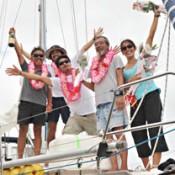
June 10, 2012 Ryukyu Shimpo
A yacht named Fang, with four people including 65 year-old skipper Takeo Kimura on board, completed a four-year voyage around the world. Kimura, who currently lives in Kanagawa, left Kushiro Port in Hokkaido on June 4, 2008. On June 9, 2012, he brought the yacht and its crew into the Ginowan Port Marina after being away from Japan for four years. He had actually prepared for the voyage based at the Ginowan Port Marina for the five months prior to setting sail.
After leaving Kushiro, they cruised all around the world, including Alaska, South America and Greenland. On the way, a volcanic eruption and a winter storm in Iceland forced the adventurers to hove to for six months.
Kimura said, “I came up with the idea of going on a cruise around the world from my honeymoon trip 35 years ago, in which I ventured across the Pacific Ocean.” He said, “On that occasion, we planned to go around the Pacific Ocean, but gave up part-way due to a malfunction of the yacht when we were at Easter Island. So we did the round the world voyage this time to make up for it.”
Kimura expressed his appreciation to the people who welcomed him and his crew in the Ginowan Port Marina, saying, “Wherever I went, I was treated like a guest who would be taken to wherever I wanted to go. I am really grateful to my crew members for helping me complete this voyage.”
Kimura intends to continue his yacht travel, saying, “Next, I would like to go to nearby countries such as China and the Philippines.”
(English translation by T&CT, Mark Ealey)
Go to Japanese

Go To Video











 Webcam(Kokusai Street)
Webcam(Kokusai Street)


